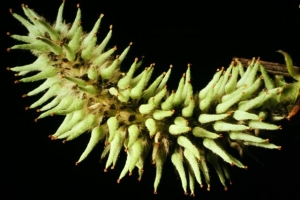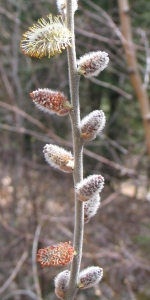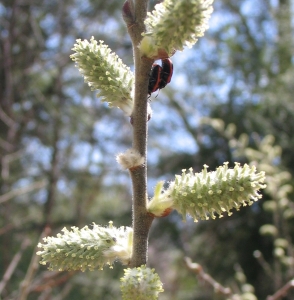Furry Stirrings of Spring
When I was in elementary school, the first sign of spring we looked for was not the crocus or daffodil; it was the silver-gray catkins of the pussy willow. There was an informal contest among us to be the first to spot them. Sometimes as late as April but often earlier, in March, someone would bring a branch of pussy willow to class, where the teacher would put it in a vase and we would sing the pussy willow song:
"I have a little pussy, her coat is silver gray; she lives out in the meadow, and she never runs away. She'll always be a kitten, she'll never be a cat, 'cause she's a pussy willow; now what do you think of that? Meow, meow, meow...."
Pussy willow is dioecious; there are plants with male flowers and plants with female flowers. The gray catkins are the male (staminate) flowers, and they do seem to be covered with cat fur; tiny kittens arrayed along the branch. There are female (pistillate) catkins too, but they are greenish and bristly, and look more like hedgehogs than cats. Pussy willows are wind pollinated, so they don't have to wait for warm weather when insect pollinators will be active. In fact, there is an advantage in timing wind pollination for March or April: not only is the weather likely to be windy, blowing the pollen from one plant to another, but there are no leaves yet to get in the way.Pussy willows are not the only shrubs or trees to have catkins; all willows have them, and they are all somewhat alike, especially when they first emerge, although the ones I know are not the pussy willow gray. Poplars, aspens, and cottonwoods, which are closely related to willows, also have similar catkins; at least, they are similar when they first appear, but then they grow much longer. The members of the Birch family, the Betulaceae (birches, alders, hazels, hornbeams, and hophornbeams), have catkins as well, and many of these are present in late winter, but you won't confuse them with pussy willows. They have long, dangling flowers that don't resemble cats at all; if they were the first catkins you had ever seen, you might wonder why they were called that. The botanical name for the plant we call pussy willow in the Finger Lakes area is Salix discolor. It is a large shrub or small tree, usually growing in wet areas in the wild, but able to grow in a yard or garden if planted there. Prairie willow, Salix humilis, a smaller shrub of dry uplands, is sometimes called small pussy willow because it has catkins that look very much like those of the pussy willow, but smaller. They are usually easy to tell apart because of the differences in size and habitat, but just to be thoroughly confusing, a hybrid of these two has been reported in this area, so if you find a pussy willow and you can't tell which species it belongs to, perhaps it is the hybrid.
Our native pussy willow is sometimes sold by plant nurseries as French pussy willow, but the real European pussy willow or goat willow, Salix caprea, is also sold; it has even larger, fluffier-looking catkins than our native shrub. If Salix discolor is a domestic shorthair, Salix caprea is an Angora. They have been selected for size and color over the years, and you may even see pink ones. The pussy willow's catkins will puff up like angry cats as they develop, and the stamen tips will turn yellow with pollen; but by that time it will be April or May, and other, showier flowers will have caught our attention.
Click image for larger versions of Fig. 2 & 3.
About
By Mark D. Inglis
Photos by Dave Spier (1), David Werier (2, 3)





